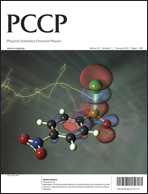Prediction of ternary alkaline-earth metal Sn(II) and Pb(II) chlorides with potential applications as p-type transparent conductors
IF 2.9
3区 化学
Q3 CHEMISTRY, PHYSICAL
引用次数: 0
Abstract
Non-metallic Sn(II) and Pb(II) compounds, particularly those with p-type properties, are essential functional materials due to their notable electronic arrangement and chemical characteristics. The presence of additional Sn(II) and Pb(II) chlorides is suggested by the existence of known Sn(II) and Pb(II) compounds. By utilizing first-principles calculations and swarm intelligence structure search techniques, we have predicted the existence of up to seven new ternary alkaline-earth metal chlorides: ABCl4 (where A = Sr and B = Sn or Pb) and AB2Cl6 (where A = Mg, Ca, or Ba and B = Sn, or A = Ca or Sr and B = Pb). These seven chlorides are in the divalent state. The interaction between Sn-5s (or Pb-6s) and Cl-3p in these compounds creates an anti-bonding effect in the upper valence bands, which enhances defect tolerance and promotes high p-type conductivity. These stable chlorides exhibit notable electronic properties, including wide band gaps ranging from 3.91 to 4.94 eV, broad hole effective masses ranging from 0.93 to 5.62 m0, and high valence band alignments ranging from 6.83 to 8.38 eV under vacuum. Specifically, Ca/BaSn2Cl6 and CaPb2Cl6 have the potential to be used as p-type transparent conductors due to their favorable properties, including a lower hole effective mass (0.93 m0 for CaPb2Cl6) and higher ionization potentials (6.83/7.05 eV for Ba/CaSn2Cl6). Furthermore, the predicted CaPb2Cl6 crystal exhibits an attenuated negative linear compressibility and negative zero-linear-compressibility of the c-axis in different pressure ranges due to the wine-rack structure. This report highlights potential applications for alkaline-earth metal Sn(II) and Pb(II) chlorides, including their use as transparent conductors, particularly the p-type.预测可能用作 p 型透明导体的三元碱土金属 Sn(II) 和 Pb(II) 氯化物
非金属锡(II)和铅(II)化合物,尤其是具有 p 型特性的化合物,因其显著的电子排列和化学特性而成为重要的功能材料。已知 Sn(II) 和 Pb(II) 化合物的存在表明还存在其他 Sn(II) 和 Pb(II) 氯化物。通过利用第一性原理计算和群集智能结构搜索技术,我们预测了多达七种新的三元碱土金属氯化物的存在:ABCl4(其中 A = Sr,B = Sn 或 Pb)和 AB2Cl6(其中 A = Mg、Ca 或 Ba,B = Sn,或 A = Ca 或 Sr,B = Pb)。这七种氯化物都处于二价状态。在这些化合物中,Sn-5s(或 Pb-6s)和 Cl-3p 之间的相互作用在上价带产生了反键效应,从而提高了缺陷容限并促进了高 p 型导电性。这些稳定的氯化物表现出显著的电子特性,包括 3.91 至 4.94 eV 的宽带隙、0.93 至 5.62 m0 的宽空穴有效质量以及真空下 6.83 至 8.38 eV 的高价带排列。具体来说,Ca/BaSn2Cl6 和 CaPb2Cl6 具有较低的空穴有效质量(CaPb2Cl6 为 0.93 m0)和较高的电离电位(Ba/CaSn2Cl6 为 6.83/7.05 eV)等有利特性,因此有潜力用作 p 型透明导体。此外,由于酒架结构,预测的 CaPb2Cl6 晶体在不同压力范围内表现出衰减的负线性可压缩性和 c 轴的负零线性可压缩性。本报告强调了碱土金属 Sn(II) 和 Pb(II) 氯化物的潜在应用,包括用作透明导体,尤其是 p 型导体。
本文章由计算机程序翻译,如有差异,请以英文原文为准。
求助全文
约1分钟内获得全文
求助全文
来源期刊

Physical Chemistry Chemical Physics
化学-物理:原子、分子和化学物理
CiteScore
5.50
自引率
9.10%
发文量
2675
审稿时长
2.0 months
期刊介绍:
Physical Chemistry Chemical Physics (PCCP) is an international journal co-owned by 19 physical chemistry and physics societies from around the world. This journal publishes original, cutting-edge research in physical chemistry, chemical physics and biophysical chemistry. To be suitable for publication in PCCP, articles must include significant innovation and/or insight into physical chemistry; this is the most important criterion that reviewers and Editors will judge against when evaluating submissions.
The journal has a broad scope and welcomes contributions spanning experiment, theory, computation and data science. Topical coverage includes spectroscopy, dynamics, kinetics, statistical mechanics, thermodynamics, electrochemistry, catalysis, surface science, quantum mechanics, quantum computing and machine learning. Interdisciplinary research areas such as polymers and soft matter, materials, nanoscience, energy, surfaces/interfaces, and biophysical chemistry are welcomed if they demonstrate significant innovation and/or insight into physical chemistry. Joined experimental/theoretical studies are particularly appreciated when complementary and based on up-to-date approaches.
 求助内容:
求助内容: 应助结果提醒方式:
应助结果提醒方式:


